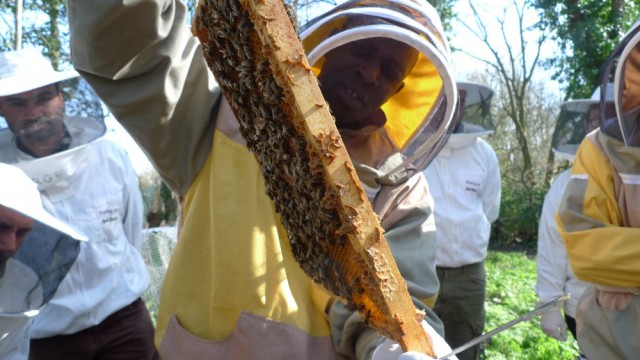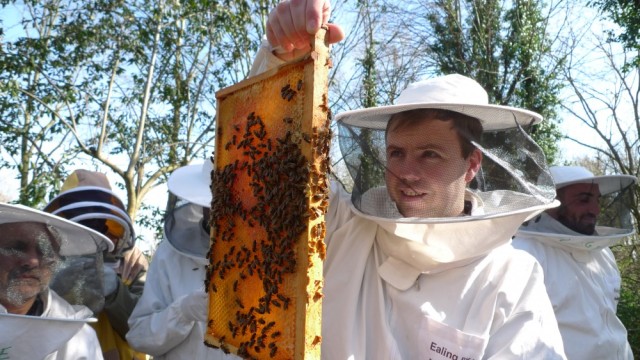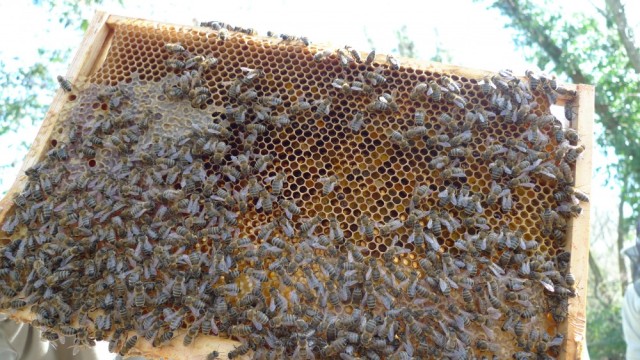Yesterday wasn’t predicted to be sunny. And yet it was. The whole apiary was lit up; the daffodils glowed, the bees zoomed.
It was the first practical session for this year’s intake of newbee beekeepers doing the Ealing association’s beginners course. There was some moaning from a few of the men as apparently the rugby was on! But they were very lucky really – if it had been raining we wouldn’t have been able to do anything, but instead they all helped me inspect our three hives. Exciting for me too as it was the first time I’ve seen inside the hives since early October.
There were six newbies (four men & two ladies – incidentally mostly in their late twenties/early thirties I think), none of whom had ever looked inside a hive before. So they were learning the very basics: checking the crown board for the queen, prising frames apart with a hive tool, holding the frames vertically so that nectar doesn’t fall out, keeping the frames over the hive in case the queen falls off and how to put the hive back together without squashing bees.
There is quite a lot to learn which you take for granted once you’ve had practice. For instance, I found it hard to distinguish between dark capped honey and capped brood in the beginning. Many people mistake drones for queens at first. Is that bell shaped bit of comb you’re looking at a ‘charged’ queen cell with a larvae inside, or just a play cup?
I was pleased that everyone had a go and no-one seemed afraid of the bees. One person had no gloves on at all and the rest thin latex gloves. Our bees are really docile so there were no stings or even any agitation. Plus we saw all three queens, what a treat!
The only downer from my point of view was that Chamomile’s ladies in their two brood boxes has very little brood – only about a frame and a half. There’s a load of honey and pollen in the top box but not much going on down below where Chamomile is. The other two colonies (headed up by Queens Myrtle and Chilli) had at least double that amount of brood.
Being slow to build up in spring is a classic symptom of nosema, so I’m wondering if feeding some thymol syrup would be a good idea. Does anyone know any good recipes? Thornes is selling Vitafeed Gold, which they say “is particularly effective when applied to colonies infected with nosema” – but I have no experience of using this myself. In the past I’ve used Fumadil B as a preventative, which is no longer licensed for use in the UK.
Also, having just read Randy Oliver’s post on The Nosema twins: alternative treatments, he says “A recent study by Eischen (2008) indicates that feeding pollen supplement during winter may be as effective as fumagillin treatment for promoting health of colonies with light infections!”. I have some Nektapol supplement, so this may be the best colony to give it to. It’s also possible that Chamomile was poorly mated after she emerged last year and is running out of eggs, causing her to slow down production. Welcome to the beekeepers’ guessing game.
After a cup of tea I went to meet up with Tom and one of the managers of a local allotment site. We were checking out a plot to see if we can put bees there. Even though there is a huge waiting list for the allotments, several gardeners have turned the plot down as it’s bordered by trees and a bit overgrown with brambles. However, with a bit of tidying up it’ll be grand for bees. And for the tidying we may even get the help of some young offenders doing community service!
As long as none of the other allotment holders turn out to be allergic to bees, it looks hopeful that we can move our bees there from their current location in Hanwell, as their current site is a bit problematic for a few reasons. Fingers crossed.








Great post Emily, for those of us still in the grips of winter, all “bee-starved boys” to quote Dr.
Wyatt Mangum! Our daffodils are just 4″ green shoots; we are likely three weeks behind you, weather-wise. As for Queen Chamomile, you have time to try to help that hive via some treatment ie. thymol syrup (I would try to make it thymol in honey syrup if you have your own clean honey to give back to them) while you have the hive tested for Nosema. Do you use probiotic drenches in the UK? But it just may be she’s not the best queen in the world…so if the brood volume does not pick up with warmer weather and optimal conditions, I would put her in a nuc and give the girls a new queen or let them raise a queen cell from one of your better hives. And possibly turn them out on fresh, clean equipment too (definitely do that if your bees are positive for Nosema). Hope you post on Chamomile and how things go with that hive. We all have hives like this…just not quite right…that keep us awake at night, mulling over strategy!
LikeLike
Thanks for the advice. How would you make the honey syrup? Chamomile’s hive has plenty of stores, so I could use some of her own honey. The plan is to do a Bailey comb exchange to get the bees onto fresh comb. Wishing you daffodils soon!
LikeLike
I’m glad you finally have had a look at your hives. I don’t know how you can stand not seeing inside the hives since October. That’s over four months. It was also nice to see the daffodils reflecting the sun…so much color as a contrast to some of your winter pictures.
The UK was smart to ban Fumagillin. As I understand, it can cause birth defects. The US still sells it and some of our bee club members swear by it.
As for me, one hive died out. It tested positive for nosema. Another hive robbed the honey from that hive, so they will have gotten it. I’ll keep an eye on them, but I am strictly “non-treatment” so it’s going to be tough love. So far they are my best hive.
LikeLike
It always feels like a everlasting wait to see the bees again – and then everything begins happening at once and we have to spring into action.
Sorry to hear about your hive. What I hate about nosema is that you can’t see it. Hope your other hive will be ok. Is there plenty of pollen about for them?
LikeLike
Hi Emily – lovely to read about the docile bees. Re nosema, the recipe can be found here http://www.beekeepingforum.co.uk/showpost.php?p=49691&postcount=44.
This year I’m going to try out the fat bee man’s recommendation which is to put a few drops of tea tree oil into the syrup for the bees – http://www.youtube.com/watch?v=A13CBGjhjzI (The problem about doing that now though is that the weather is going to turn at the end of week for the colder – which would not make feeding with syrup advisable – unless you feed with an autumn strength syrup rather than spring consistency perhaps.)
LikeLike
Thanks very much for that link and the warning about the weather. As you say, an autumn strength feed may be best.
LikeLike
Hi Emily, I think I have some Vita Gold at home. I’ll bring some up on Saturday if you want?
Llyr
LikeLike
Hi Llyr,
Thanks that is very kind of you. Only thing is, when I read the instructions on the Vita Gold website, it sounded like you need to apply it every other day, which I wouldn’t be able to do. How have you used it before?
LikeLike
Just checked, I have vita feed gold. I was giving this to my ladies last autumn to boost the hive for winter. By the size of the two colonies it wasn’t a mistake. I was mixing mine in with the suryp. I’ll bring it with me on Saturday. You can decide for your self then!
LikeLike
Ta, that’s very kind of you. See you Saturday, in the rain by the looks of it!
LikeLike
You may not be surprised by my advice which is to wait a bit before medicating. I think it’s still early, we’ve only had a couple of weeks if that of warm weather and, as long as there are no other signs of a problem I wouldn’t be surprised by low brood counts. The weather has turned cooler today, and we still half of March to go. Wait until April I would say, give the girls a chance!
LikeLike
I did wonder whether they might just be a cautious strain and not wanting to overstretch themselves! Can’t harm to get them onto fresh comb though I think.
LikeLike
Hi Emily, I am enjoying your blog and I know you read my wife’s Maywood Living blog. Was wondering what type of bees you are keeping?
LikeLike
Hi John, hard to say. I’ve never bought in bees from a breeder. They’re just local mongrels really, fairly dark and used to the local weather. How about yours?
LikeLike
Emily, I thought I had replied but I’m not seeing it so if this is a duplicate, I apologize. We have been keeping Russians for a few years now. They are supposed to winter over better and rob less than Italians. We started with Italians and they did rob alot and we lost several hives that way. Russians will rob too, we have seen that, but I started a practice of putting the entrance reducer back on a few days prior to taking honey supers off and that seems to help. Your bees are very dark, I wonder if they have Russian in them? How did you get them if not from a supplier? Were they swarm captures?
LikeLike
Hi John, Russians seem to be quite popular with US beekeepers that I follow. From what I hear they’re hardy and do well. I don’t know if you follow the lovely Cecilia on her farm at http://thekitchensgarden.com, but she has just ordered in Russians after losing her bees in an incredibly harsh winter.
Back in 2008 a local beekeeper very kindly gave me a hive of her bees, my first hive. Since then Emma and I have kept that line of bees going, doing splits and letting them produce their own new queens. Queen Myrtle is a direct descendant of that original colony in 2008. We also bought a colony last year from a beekeeper who was giving up and split that in the summer, ending up with Queens Chamomile and Queen Chilli. I’m not sure where his bees came from.
Queen Myrtle is the most yellow of her family line so far, so I hope we’re not going to lose that darkness. The original British sub-species of Apis Mellifera were dark bees. In his book ‘Practical Beekeeping‘ (1997) Clive de Bruyn suggests that the dark bees now present here are not necessarily descended from the British Black bee, as large numbers of continental dark bees were imported in the early 20th century from France and Holland to compensate for the heavy losses of bees due to the ‘Isle of Wight’ disease.
In their book ‘Keeping Healthy Honey Bees‘ (2010), David Aston and Sally Bucknall say “The honey bees of the British Isles are a mixture of genetic types produced through the introduction of strains of bees from abroad, the Dark European Honey bee and its variants, and those produced through crossing with imported strains and races of honey bees.” The British are mongrels and our bees are too!
LikeLike
Maybe you have Buckfast. Pictures I’m seeing they look pretty dark, even darker than my Russians
LikeLike
Thanks for the link to Cecelia, no I have not been following her. Glad your bees are doing well. Took a peek in one hive today since we had 5 inches of snow on St Paddy’s day and was still only in the 30’s since. Don’t know what that is in centigrade
LikeLike
Some interesting thoughts on nosema. I’m glad you’ve had a look at your bees and they’re doing well. Two of my hives are still grumpy so I envy you all your docile ones! I’m pleased to hear the allotment is a possible new site, too
LikeLike
Thanks Wendy, sorry to hear your bees are grumpy! I know I’m very lucky with mine.
LikeLike
Pingback: A string of warm days and daffodils | Miss Apis Mellifera